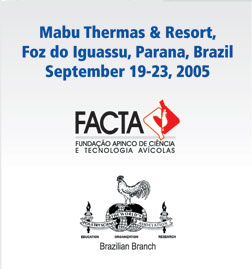Contributed Papers: Oral Presentations
Cell Biology |
Investigation
of the role of proteoglycans during invasion of Eimeria
tenella sporozoites
Janene Bumstead and Fiona Tomley
Institute for Animal Health, Compton.
The ability
of Toxoplasma, Plasmodium, Eimeria and Neospora parasites
to invade a wide range of epithelial cells in vitro
suggests that these parasites recognise abundant or
widely distributed molecules on the cell surface.
A large array of glycosoaminoglycans (GAGs) are found
on the surface of nearly all vertebrate cells and
many pathogens including Plasmodium (Pancake et al.,
1992 J. Cell Biol 117, 1351-1357)) and Toxoplasma,
(Carruthers et al., 2000, Inf. Immun. 68, 4005-4011;
Ortega-Barria and Boothroyd, 1999, J. Biol Chem 274,
1267-1276) have evolved strategies to recognise them.
Experiments
presented here show that GAGS are important receptors
for attachment and invasion of E. tenella sporozoites
in vitro. The most common GAG on the cell surface
is heparan sulphate, (HS), and both HS and heparin
inhibited the invasion of sporozoites in vitro. In
contrast there was no difference in the numbers of
sporozoites able to invade GAG-deficient Chinese Hamster
Ovary (CHO) cells compared to the CHO parent line
over a period of 1 hr. However, further experiments
showed that significantly fewer sporozoites adhere
to or invade the GAG-deficient lines when the time
of incubation is reduced. In addition, sporozoites
and cells are incubated with constant rocking, significantly
fewer sporozoites adhere to the GAG-deficient cell
lines compared to the CHO parent line.
These
results suggest that GAGS could play a role in the
initial contact of sporozoites with host cells and
may be important for facilitating rapid parasite attachment,
particularly under ‘flow’ conditions.
They may be significant in vivo where the movement
of the caecal contents could inhibit adhesion.
